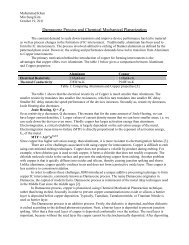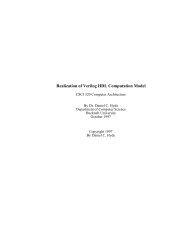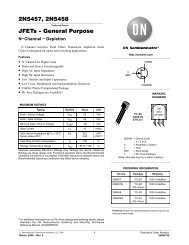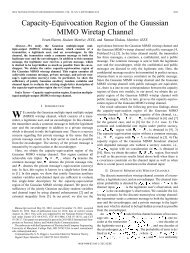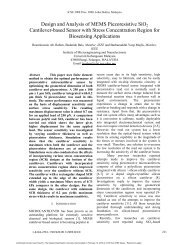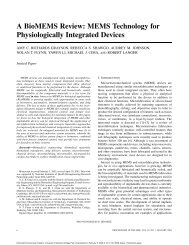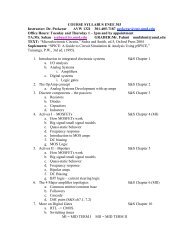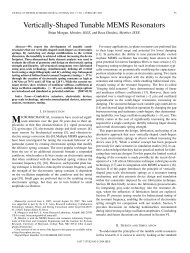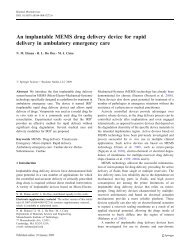MO P1-27.pdf - University of Maryland
MO P1-27.pdf - University of Maryland
MO P1-27.pdf - University of Maryland
Create successful ePaper yourself
Turn your PDF publications into a flip-book with our unique Google optimized e-Paper software.
density <strong>of</strong> 31 A/cm 2 and eliminate requirements for beam<br />
compression. This dramatically simplified the gun design and<br />
improved the beam quality. The estimated lifetime exceeds<br />
90,000 hours.<br />
Figure 3. Photograph <strong>of</strong> 15-beam electron gun with CPR<br />
cathodes operating at 30 A/cm 2<br />
Figure 4 shows a solid model <strong>of</strong> the segmented MIG being<br />
built for KIT. The gun will be used to study the effects <strong>of</strong> nonuniform<br />
cathode emission on<br />
gyrotron performance. The<br />
current emitted from each<br />
segment will be externally<br />
controlled.<br />
Photocathode research is<br />
focused on extending the<br />
reservoir concept to<br />
photocathode materials with<br />
higher quantum efficiency.<br />
The Figure 6 shows current Figure 4. Solid model <strong>of</strong><br />
performance <strong>of</strong> photocathodes,<br />
including the recent advance<br />
for cesiated tungsten. CPR<br />
segmented MIG using CPR<br />
cathodes<br />
photocathodes use a modified version <strong>of</strong> the configuration<br />
shown in Figure 2. Because <strong>of</strong> the increased volatility <strong>of</strong><br />
cesium, the reservoir is capped by a section <strong>of</strong> sintered<br />
tungsten powder. This is followed by a mixing section and<br />
controlled porosity material for uniform cesium distribution<br />
over the surface. The unique feature <strong>of</strong> this configuration is<br />
that the cesium diffusion can be precisely controlled to match<br />
the surface evaporation rate.<br />
Current research is investigating evaporative and atomic<br />
layer deposition to deposit higher quantum efficiency<br />
materials onto the CPR tungsten material. Experiments will<br />
measure both the quantum efficiency <strong>of</strong> the photocathodes and<br />
the evaporation rate <strong>of</strong> cesium. This will allow estimation <strong>of</strong><br />
the lifetime. The goal is to increase the lifetime <strong>of</strong> high<br />
quantum efficiency materials by two orders <strong>of</strong> magnitude or<br />
more.<br />
Cathode and photocathode designs will be describes as well<br />
as available experimental results.<br />
Figure 6. Quantum efficiency and lifetime for common<br />
photocathode materials. Some cathodes have longer<br />
reported lifetimes under high vacuum, so the graph is<br />
normalized to a nanoTorr, assuming contaminationlimited<br />
lifetime scales linearly with chamber pressure.<br />
Figure 5. CPR configuration for cesiated photocathodes<br />
IV. SUMMARY<br />
CPR cathodes provide increased performance for both<br />
thermionic and photocathodes. This will lead to improved<br />
electron guns for electron beam devices<br />
V. ACKNOWLEDGEMENTS<br />
This research was supported by U.S. Department <strong>of</strong> Energy<br />
grants Nos. DE-FG02-04ER83918, DE-SC0006208, DE-<br />
SC0004570, and DE-SC0009583, and by the U.S. Army<br />
Research Office under contract W911NF-08C-0051 as part <strong>of</strong><br />
the DARPA HiFIVE program.<br />
REFERENCES<br />
[1] “Controlled porosity elevates performance, lifetime <strong>of</strong> cathodes,” R&D<br />
Magazine, Vol. 53, No. 5, September 2011.<br />
[2] R. Lawrence Ives, Senior Member, IEEE, Louis R. Falce, George<br />
Miram, George Collins, “Controlled Porosity Cathodes for High Current<br />
Density Applications,” IEEE Trans. Plasma Sci., Special Edition on<br />
High Power Microwave Sources, Vol. 38, No. 6, pp. 1345-1353, June<br />
2010.<br />
[3] Eric Montgomery, et al, “Enhanced Lifetime Hybrid-Diffuser Cesium<br />
Reservoir Photocathode,” Advanced Accelerator Concepts Workshop,<br />
Austin, TX June 2012.<br />
[4] R.L. Ives, L.R. Falce, S. Schwartzkopf, and R. Witherspoon, “Controlled<br />
Porosity Cathodes from Sintered Tungsten Wires, IEEE Trans. On<br />
Electron Devices, Vol. 52, No. 12, pp. 2800-2805, December 2005.




